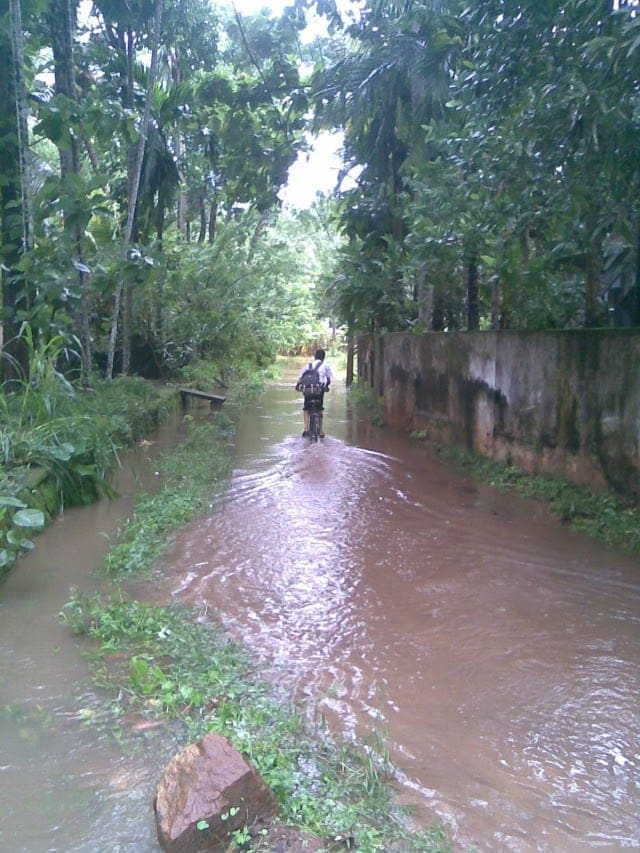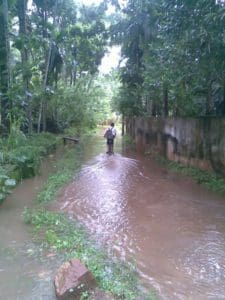
Long, long ago, when I went to work at St. Agnes College in Mangalore, my father had just retired from government service, and settled down in our ancestral home, then known as the “Big House” in Kotecheri, Kanhangad, South Kanara District, now a part of Kerala State. Kerala and the Malabar Coast lying on the lee side of the Western Ghats is blest with heavy rains during the Monsoons. I used to visit my parents when I had a chance – 3 to 4 pleasant days – off from work. My father, usually met me at the Kanhangad railway station; and we used to walk home together. When he could not, my father sent the servant, Kutia. The preferred transportation from Mangalore to Kanhangad, in those days, was the railway train starting from Mangalore, and taking about two hours for the run to Kanhangad.
It was on one of those rainy days, that I decided to go home. With a suit case, an umbrella, and my handbag, I got into a taxi from St. Agnes College to catch the morning train at 9 AM. On entering the taxi, I met a heavy down pour; and water was everywhere. Most of the streets and roads were partly or fully submerged under an inch or two of water. It was warm and humid. The water on the streets and the tires of the taxi appeared to have conspired to have the red muddy water to splash all over, and up to the railway station. I could not even open the window to get some little fresh air. On arrival at the Mangalore Railway Station, I bought my ticket and repaired to the waiting room for half an hour, as the train was just a tad behind, that day. At 9.30 AM, I got into the train, that started promptly on its run. I got a window seat. It was warm and humid and I opened the window just a bit, for air. Well, the running train and the poring rain seemed to have hatched another conspiracy to drench everything it could reach. It was a matter of getting soaked or staying put, in the wet humid, compartment. I chose the latter as the only desirable alternative and closed the window behind me.
The train came to a short halt at the seven stations between Mangalore and Kanhangad (Ullal, Manjeshwar, Mangalpadi, Kumbla, Kasargod, Kudlu and Bekal) and then moved on until its regular stop at my destination, Kanhangad. A peep through the window of my compartment showed that it was still raining heavily, outside. As expected, the redoubtable Kutia was there, looking for me. As usual he came to my compartment, took my suitcase, before I got down with the handbag and opened umbrella. Now, there were two routes we could take to our home: one was the long 3 or 4 (it seemed like that) miles of round about stretch, by taxi. And then, there was a short cut, about a mile and a half. Taxis come to the station usually after half an hour of being ordered; but an hour perhaps, on a rainy day. Again, the taxi cannot go near the house, leaving about half a furlong (1/16th mile) of water-drenched, red, rocky, unfinished roadways, to be negotiated by foot.
We took the short cut. This route goes over and past the railway tracks. I started walking with Kutia close behind me. We crossed the railway track, alongside many people walking to town by the same route. A crowd of passengers with open umbrellas were crossing the track and walking the narrow field, leading to town through a paved street. The street is about half a mile, lined with grocery stores, small hotels (restaurants) and some homes in between. We knew most of the people and as I walked in the rain, I could see some faces under the umbrella and said hello. This street goes up to the elementary school – Balla school which consisted of one large room and plenty of front yard for children to play. The children were bunched in five grades in this one hall and there were a couple of teachers. But the students did learn; and today, some of the alumni of this school are doctors, engineers and some of them are in the US, UK, and other foreign countries!
Now there are three to four types of regions(?) We have to cross to reach home. First of all, the 3 – 4 red rocky narrow lanes, 2-3 inches of muddy water, gushing from this end to the other! So, to save the slippers, I took the slippers and the handbag in one hand and the saree (a bit above the ankles) and the open umbrella in the other hand and walked through these lanes – felt like a three-ring circus! I do not believe the present generation can even imagine this rope trick!. The lanes were just a few yards each, but looked like a mile. Then you have to cross a couple of paddy fields flooded and buried in muddy water, with tips of green grass peeping through – you walk on a plain strip of land between two such large rice fields. Crossing the fields is an adventure by itself.
The third type of travel is through backyards/front yards of houses, mostly belonging to uncles and cousins. These yards were well maintained, but the monsoons cared less. Some of the yards were filled with an inch or half of water! A narrow path was paved across the yard. And as was the custom, each yard had a small gate which one has to climb (jump over) and cross over to the next yard. No human beings could be seen outside that day for obvious reason. The last but our house belonged to one of our uncles and was called “upper house .” It is so, because the ground was above all the other grounds around. Remember, Thank you was unheard of, I guess. We never thanked any one, but took it for granted and went through all these yards and lanes so casually that one would feel that it all belonged to one family. Rightly so. A number of cousins, uncles, and nephews lived with their families around this area. At the end of this path there was another gate which needed to be jumped over and go down a few steps – now you know why the house was called so. And behold, there was our home. Here also was a gate to be jumped over to enter our front yard. My parents were worried and waiting for me because Kutia had reached home much before I arrived.
I am a slow walker. A cup of hot coffee and some snacks were awaiting. It was so good seeing my parents although I see them at least once in three or four weeks. I started talking to my mother as she was getting busy with lunch preparation. This was a big house indeed, at least when it was built at the end of the 19th century. Today, when I muse over it, I wonder how my grand father thought of this house – a two storey, brick house with 10 rooms and a large and centrally located, God’s (prayer) room. In addition, there was a long hall and one above that. A large kitchen and a large dining room, and a bath room of sizable area and a well with clear water both away from the house and not far from the kitchen!
There was a nice masonry wall between the front yard and the bathroom, with an arched entrance. I am amazed at the construction of this custom built house, in consideration of all conveniences and comforts of a joint family. Of course, the latrine was unheard of in those days and was built later!
Now this big house belongs to my grand father’s and his brothers’ numerous grand, great, grand -, great, great, grand – and great, great, great grand – children who are located in various parts of India and abroad. But those who are there visit and take care of the house, particularly the prayer room . God bless us all. Good Old days indeed.
This is a Guest post by Dr. Savitri K. Kamath PhD, Scottsdale, Arizona.

Nice one, it brought back some sweet memories of the 80’s and 90’s.